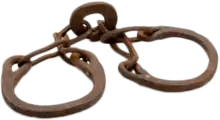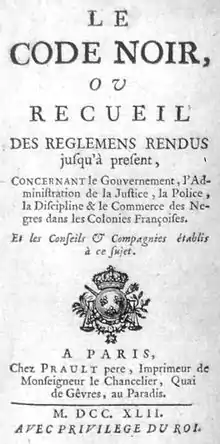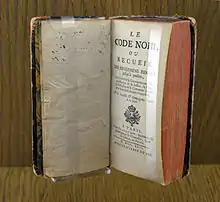Code Noir
The Code Noir (French pronunciation: [kɔd nwaʁ], Black Code) was a decree originally passed by France's King Louis XIV in 1685. The Code Noir defined the conditions of slavery in the French colonial empire, restricted the activities of free Black people, made Roman Catholicism compulsory, and ordered all Jews out of France's colonies.
| Part of a series on |
| Slavery |
|---|
 |

The Code Noir governed many black people in an often harsh slavery, but did not relieve the brutality of that slavery in many areas under French control. In some areas it resulted in a higher percentage of black people being free people of colour than in the British system (13.2% in Louisiana compared to 0.8% in Mississippi[1]). Those freed were placed under restrictions by the Code Noir but on average they were exceptionally literate, with a significant number of them owning businesses, properties and even slaves.[2][3]
The code has been described by Tyler Stovall as "one of the most extensive official documents on race, slavery, and freedom ever drawn up in Europe".[4]
Context, origin and scope
International and trade context
At that time France was in competition with England which still had the Barbados Slave Code.
At this time in the Caribbean, Jews were mostly active in the Dutch colonies, so their presence was seen as an unwelcome Dutch influence in French colonial life. Furthermore, the majority of the population in French colonies were slaves. Plantation owners largely governed their land and holdings in absentia, with subordinate workers dictating the day-to-day running of the plantations. Because of their enormous population, in addition to the harsh conditions facing slaves (for example, Saint Domingue has been described as one of the most brutally efficient colonies of the era), small-scale slave revolts were common. Despite some well-intended provisions, the Code Noir was never effectively or strictly enforced, in particular regarding protection for slaves and limitations on corporal punishment.
Legal context
Leonard Oppenheim,[5] Alan Watson[6] or Hans W. Baade[7] were wrong to consider Roman law was the basis of this new law. In fact, this new law is based on the codification of previously applicable usages, decisions and rules used at that time in the Antilles.
This was shown by a Vernon Valentine Palmer study[8] which described the process which led to the Edict of 1685: 4 years, with draft and preliminary reports and the project of 52 articles, and king's instructions, known by documents in public French archives.[9]
In 1681 the king ordered the creation of a legal status for black people in the American islands, and asked Jean-Baptiste Colbert to write it. Colbert delegated this task to the Martinique intendant, Jean-Baptiste Patoulet, replaced in July 1682 by Michel Bégon, and the governor-general of the Antilles, Charles de Courbon, count of Blenac (1622–1696).
A royal memorandum to Colbert, dated 30 April 1681, shows the need of an Antilles-specific ordinance when there were no slaves in metropolitan France, due to a decision of 11 July 1315 by Louis X.
At this time, there were still at least two common law status applicable in Martinique: French status, the Custom of Paris, and aliens one. Soldiers, nobles, and clergy had specific status. Additionally, the Edict of 28 May 1664 established the French West India Company which applied to American islands which superseded the Compagnie de Saint-Christophe (1626-1635) and the Company of the American Islands (1635–1664).
Native people known as Indiens caraïbes had French status with the same rights as French people, although only after their baptism into the Catholic religion. It was forbidden to enslave them.
Two sources of people were planned for: native people and people of French origin. The 1664 edict did not plan for either slaves or the import of Black people.
After the West India Company went bankrupt in 1674, its insular territories reverted to the Crown lands.
Decisions of Martinique's sovereign council remedied the absence of law related to slavery: in 1652, it extended the probition on requiring domestic workers to work on Sundays also apply to slaves; in 1664, it required them to be baptised and given religious education.[10]
The edict of 1685 recognized those slavery practices incompatible with both (metropolitan) French laws[11] and Canon law.[12]
Origins
In his 1987 analysis of the Code Noir's significance, Louis Sala-Molins claimed that its two primary objectives were to assert French sovereignty in its colonies and to secure the future of the cane sugar plantation economy. Central to these goals was control of the slave trade. The Code aimed to provide a legal framework for slavery, to establish protocols governing the conditions of inhabitants of the colonies, and to end the illegal slave trade. Religious morals also governed the crafting of the Code Noir; it was in part a result of the influence of the influx of Catholic leaders arriving in Martinique between 1673 and 1685.
Versions and territories of application
The Code Noir was one of the many laws inspired by Jean-Baptiste Colbert, who began to prepare the first (1685) version. After Colbert's 1683 death, his son, the Marquis de Seignelay, completed the document. It was ratified by Louis XIV and adopted by the Saint-Domingue sovereign council in 1687 after it was rejected by the parliament. It was then applied in the West Indies in 1687, Guyana in 1704, Réunion in 1723, and Louisiana in 1724.
The second and third versions of the code were passed by Louis XV at age 13 in 1723 and 1724.
In Canada, slavery received legal foundation from the king from 1689 to 1709. The Code Noir was not intended for or applied in New France's Canadian colony. In Canada, there never was legislation regulating slavery, no doubt because of the small number of slaves. Nevertheless, the intendant Raudot issued an ordinance in 1709 that legalized slavery.[13]
From the 18th century, Code noir referred to codification of related texts.
Summary

In 60 articles,[14] the document specified the following:
Rules about religion
- Jews could not reside in the French colonies (art. 1)
- Slaves must be baptized in the Roman Catholic Church (art. 2)
- Public exercise of any religion other than Roman Catholicism was prohibited; masters who allowed or tolerated it by their slaves could also be punished (art. 3)
- Only Catholic marriages would be recognized (art. 8)
Rules about sexual relations and marriage
- Children of a female slave and a free man:
- If the father was unmarried, he should marry the slave concubine, thus freeing her and her children from slavery[15]
- Otherwise the punishment would be a fine for both the father and the slave's master. The fine was 2000 pounds of sugar (art. 9)
- If the father was the slave's master, in addition to the fine, the slave and any resulting children would be removed from his ownership, but not freed (art. 9)
- Weddings between slaves strictly required the master's permission (art. 10) but also required the slave's own consent (art. 11)
- Children born to married slaves were also slaves, belonging to the female slave's master (art. 12)
- Children of a male slave and a free woman were free; children of a female slave and a free man were slaves (art. 13)
Prohibitions
- Slaves must not carry weapons except under permission of their masters for hunting purposes (art. 15)
- Slaves belonging to different masters must not gather at any time under any circumstance (art. 16)
- Slaves should not sell sugar cane, even with permission of their masters (art. 18)
- Slaves should not sell any other commodity without permission of their masters (art. 19–21)
- Masters must give food (quantities specified) and clothes to their slaves, even to those who were sick or old (art. 22–27)
- (unclear) Slaves could testify but only for information (art. 30–32)
- A slave who struck his or her master, his wife, mistress or children would be executed (art. 33)
- A slave husband and wife and their prepubescent children under the same master were not to be sold separately (art. 47)
Punishments
- Fugitive slaves absent for a month should have their ears cut off and be branded. For another month their hamstring would be cut and they would be branded again. A third time they would be executed (art. 38)
- Free blacks who harboured fugitive slaves would be beaten by the slave owner and fined 300 pounds of sugar per day of refuge given; other free people who harboured fugitive slaves would be fined 10 livres tournois per day (art. 39)
- If a master had falsely accused a slave of a crime and as a result, the slave had been put to death, the master would be fined (art. 40)
- Masters may chain and beat slaves but may not torture nor mutilate them (art. 42)
- Masters who killed their slaves would be punished (art. 43)
- Slaves were community property and could not be mortgaged, and must be equally split between the master's heirs, but could be used as payment in case of debt or bankruptcy, and otherwise sold (art. 44–46, 48–54)
Freedom
- Slave masters 20 years of age (25 years without parental permission) may free their slaves (art. 55)
- Slaves who were declared to be sole legatees by their masters, or named as executors of their wills, or tutors of their children, should be held and considered as freed slaves (art. 56)
- Freed slaves were French subjects, even if born elsewhere (art. 57)
- Freed slaves had the same rights as French colonial subjects (art. 58, 59)
- Fees and fines paid with regard to the Code Noir must go to the royal administration, but one third would be assigned to the local hospital (art. 60)
In popular culture
The Code Noir is mentioned in Assassin's Creed IV: Freedom Cry, as it is mainly set in Port-au-Prince. The assassin Adéwalé, formerly an escaped slave turned pirate, aids local Maroons in freeing the slaves of Saint-Domingue (now the Republic of Haiti). It is mentioned during the main story of Assassin's Creed IV: Black Flag and has its own database entry in the game which provides background on the Code Noir.
See also
References
- Rodney Stark, "For the Glory of God: How Monotheism Led to Reformations, Science, Witch-hunts, and the End of Slavery", p.322 Note that the original hardcover contained a typographical error stating "31.2 percent"; this was corrected in the paperback edition to 13.2. This is confirmed by examination of the 1830 census.
- Samantha Cook,Sarah Hull, "The Rough Guide to the USA"
- Terry L. Jones, "The Louisiana Journey", p.115
- Stovall, p. 205.
- Oppenheim, Leonard. The Law of slaves: a comparative Study of the Roman and Luisiana System, 1940.
- Watson, Alan. Slave Law in America, 1985.
- Baade, Hans W. Law of slavery in spanish Luisiana 1769–1803.
- "Essai sur l'origine et les auteurs du Code noir", in Revue de droit international comparé, No. 1, 1998.
- Archives de l'Outre-Mer, à Aix-en-Provence, Col F/390.
- Cornec (6 September 2019). Un royaume antillais: d'histoires et de rêves et de peuples mêlés. L'Harmattan. ISBN 9782747585897. Retrieved 6 September 2019.
- The royal instructions written by Colbert stated that the law is slavery was "new and unknown in the kingdom".
- Pope Paul II, Veritas ipsa, 1537.
- see Virtual Museum of New France
- Full text of the "Code Noir" Archived 4 March 2007 at the Wayback Machine
- Aubert, Guillaume (July 2004). "'The Blood of France': Race and Purity of Blood in the French Atlantic World". The William and Mary Quarterly. 61 (3): 464. doi:10.2307/3491805. JSTOR 3491805.
External links
- Le code noir ou Edit du roy (in French). Paris: Chez Claude Girard, dans la Grand'Salle, vis-à-vis la Grande'Chambre. 1735.
- Édit du Roi, Touchant la Police des Isles de l'Amérique Française (Paris, 1687), 28–58.
- Le Code noir (1685)
- The "Code Noir" (1685) (in English), trans. John Garrigus
- Tyler Stovall, "Race and the Making of the Nation: Blacks in Modern France." In Michael A. Gomez, ed. Diasporic Africa: A Reader. New York: New York University Press. 2006.
- "Slavery". The Canadian Encyclopedia. Archived from the original on 29 November 2011. Retrieved 7 November 2016.
